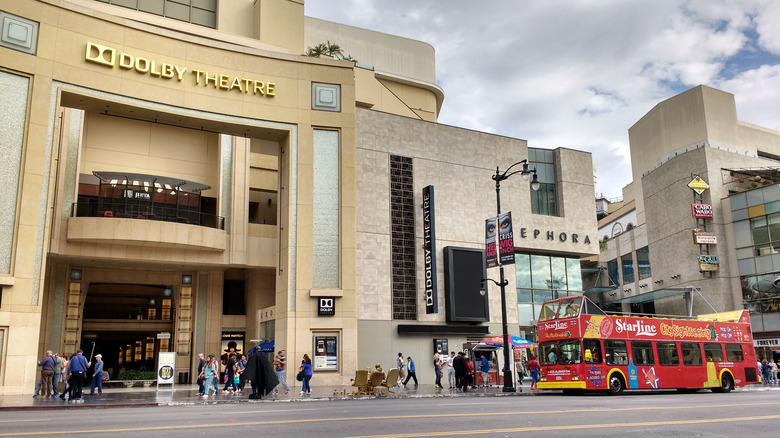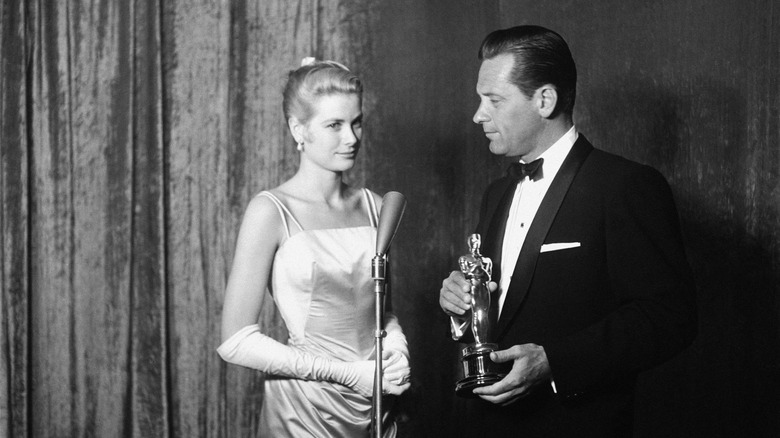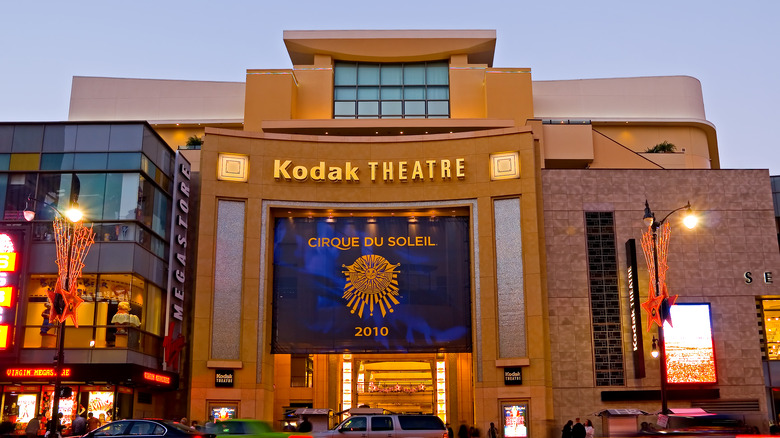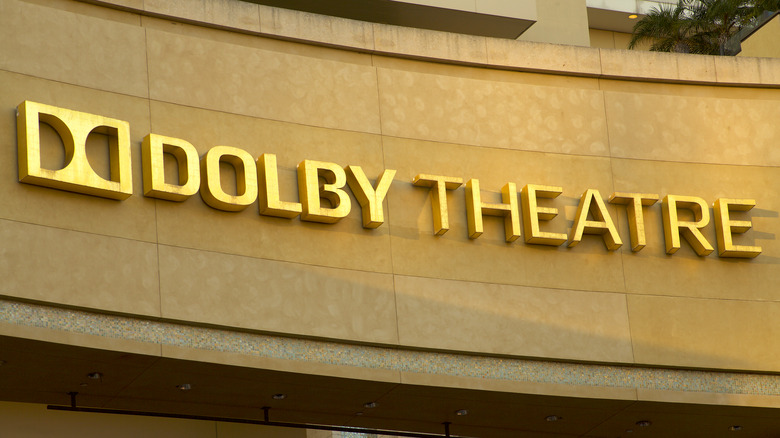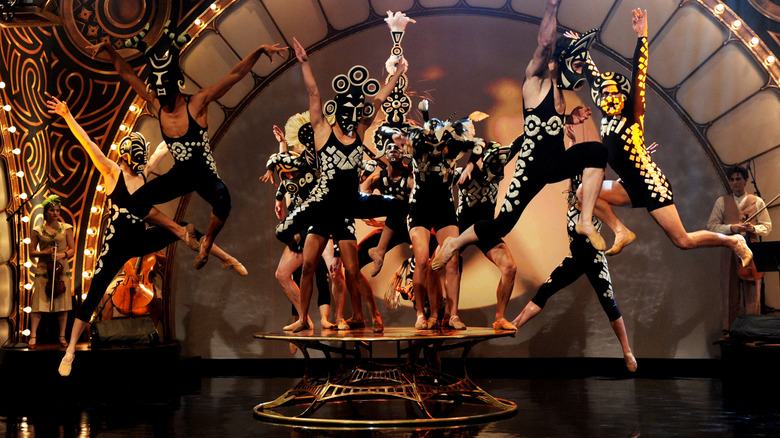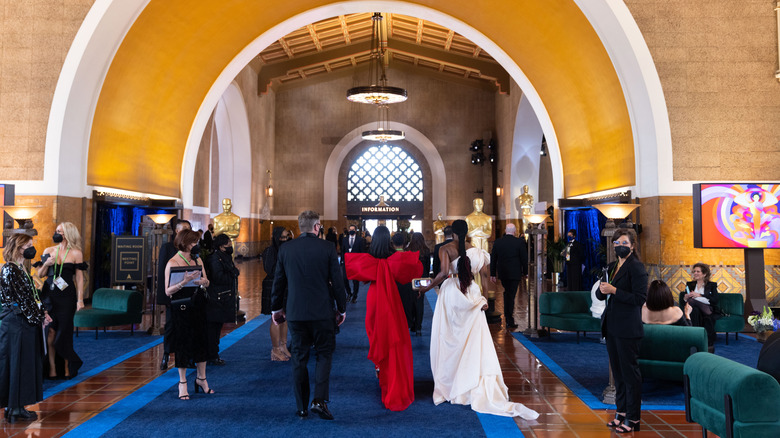The Untold Truth Of The Dolby Theatre
According to the Los Angeles Almanac, every single Academy Awards since 2002 — with one exception — has taken place in Hollywood's Dolby Theatre, with the film industry's best and brightest packing into the seats and crossing their fingers in hopes of taking home an Oscar.
The theatre has had a few different names over the years. It was initially known as the Kodak Theatre until 2012 when it was temporarily rebranded as the Hollywood and Highland Center Theatre — a nod to its location in the Hollywood & Highland (now called Ovation Hollywood) retail and entertainment complex. In May 2012, audio and video company Dolby Laboratories purchased the naming rights to the theatre, and it was renamed again to the Dolby Theatre in June 2012, per Historic Theatre Photos.
In addition to the Academy Awards, the theatre has also hosted the ESPY Awards, NAACP Image Awards, BET Awards, AFI Lifetime Achievement Awards, and Daytime Emmy Awards, as well as television specials and movie premieres.
The need for a permanent home for the Oscars
For the first 73 years that the Academy Awards were held, there was no permanent venue for the ceremony. According to Los Angeles Almanac, the first Academy Awards was held in 1929 at the Hollywood Roosevelt Hotel. Then through the 1930s and part of the 1940s, the show bounced between the Ambassador Hotel and the Biltmore Hotel. Over the years, the awards show would make its way to Grauman's Chinese Theatre and the Academy of Motion Picture Arts and Sciences Melrose Avenue theatre before RKO Pantages Theatre took over for the duration of the 1950s.
The show was held at the Santa Monica Civic Auditorium from 1961 to 1968, before the Dorothy Chandler Pavilion of the Music Center of L.A. County became the host venue, before alternating on an almost yearly basis with the Shrine Auditorium. However, by 2001, it was time for the Oscars to movie into its new permanent home.
The Kodak Theatre opens
The Dolby Theatre was completed in 2001 and was opened under its original name, the Kodak Theatre, with a concert from British tenor Russell Watson with the Hollywood Bowl Orchestra and Choir. It was designed by David Rockwell, founder of Rockwell Group, an architectural firm that has worked on stadiums, hotels, casinos, clubs, and of course, theatres (via Historic Theatre Photos). The theatre was designed with the idea of it being an ideal location to hold large-scale events that were also being televised. According to Rockwell Group, this was done by combining "glamour with function." The space needed to be able to handle the technical rigors of holding such events, but without compromising the aesthetics typically seen in traditional theatres.
One of the features built to accomplish this was a media cockpit that holds broadcasting equipment located on a hydraulic lift in the middle of the orchestra pit, which can be lowered out of sight if need be. The theatre also has the flexibility to adjust its seating configuration. While a 2,000-person capacity might be ideal for live shows held at the theatre, capacity can be expanded to over 3,000 for the Academy Awards.
The theatre changes its name ... twice
According to Historic Theatre Photos, when the theatre opened in 2001, Eastman Kodak had purchased the original naming rights to the theatre for a sum of $72 million. In 2012, the company was having difficulties adapting to a consumer photography industry that had moved to digital and was forced to file for bankruptcy (via ABC 27).
The owners of the theatre tried to fight for the company to continue its naming rights deal that was signed in 2000 and was to last 20 years. However, Eastman Kodak won in court and was able to break their deal with the theatre. This left a brief stretch where the theatre went by the name Hollywood & Highland Center — after the complex in which it's located — while a new naming rights holder was sought.
In May 2012, Dolby Laboratories was announced as the new naming rights holder on a 20-year deal. At the same time, the Academy of Motion Picture Arts and Sciences signed a new contract to keep the Oscars at the theatre for another 20 years. This was big, as there was interest from other venues in moving the Academy Awards.
The new name also brought with it Dolby's audio technology, and the theatre was equipped with a state-of-the-art sound system and other technological upgrades.
Another permanent resident flounders
The year before the drama around the theatre's naming rights unfolded, a new tenant moved into the theatre. It was a show produced by Cirque du Soleil titled "Iris." According to Cirque du Soleil, the show combined dancing, acrobatics, projections, and live music and served as a tribute to cinema. The show also featured music composed by Danny Elfman, known for his work on many films, as well as the theme song for "The Simpsons." It seemed like "Iris" would be a perfect fit given its home right in the heart of Hollywood.
The show also required some upgrades and alterations to the theatre itself. According to Historic Theatre Photos, stage lifts that reached 44 feet below the original stage were added, carrying with them a price tag of approximately $40 million.
"Iris" opened in 2011 and held performances every month except for February, which is typically when the theatre is set up for the Academy Awards, per Billboard. However, it was closed down by early 2013 due to low ticket sales.
The 2021 Academy Awards take a field trip
While the Academy Awards were held at the Dolby Theatre under its various names from 2002 to 2020, the COVID-19 pandemic forced the 2021 ceremony to buck that trend. In need of a temporary location to host a pared-down version of the Academy Awards, the Academy of Motion Pictures Arts and Sciences looked to — where else — a train station.
Los Angeles' Union Station, to be precise. According to USA Today, the show's director, Steven Soderbergh, decided the award show would play out more like a movie than a traditional awards show. He also wanted an eye-catching set, so Union Station was selected as the location due to its architecture and ample open space for crews to work safely,
There was still a connection to the Dolby Theatre at the 93rd Academy Awards: Rockwell Group. The company, which is responsible for designing the Dolby Theatre, handled production design.
